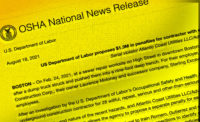Federal charges of jobsite racism against Skanska on a Memphis, Tenn. hospital project in 2009 recently reached a legal milestone. A federal appeals court last month allowed a complaint by the U.S. Equal Employment Opportunity Commission to move forward, making a trial over the charges likely.
The complaint bypasses the direct employer, Memphis subcontractor C-1 Inc., and directs the allegations against Skanska USA Building, the principal contractor.
The U.S. Court of Appeals in Cincinnati last month reversed a Tennessee federal district court's ruling on the question of whether a general contractor could be held liable to its subcontractor's employees by contending that Skanska was the "joint employer" of the workers alleging the jobsite racism, according to Bloomberg BNA.
The ruling sets the stage for trial on the facts alleged in the EEOC's complaint.
Atlanta attorney Kathryn Hinton, who is not involved with the case, recently wrote that the appeals decision “should be read as a warning” to general contractors—if there is no contrary language in agreements with subcontractors, general contractors may be held liable for a subcontractor’s employees if joint employment is implied.
Previously, Skanska’s motion to have the case dismissed was granted by a Tennessee district court on the basis that Skanska did not hire or directly employee the plaintiffs
The appeals court, however, determined that Skanska set the workers' hours, collected their time sheets, taught them how to use equipment on the construction site and required them to attend safety training.
During the construction of Methodist LeBonheur Children's Hospital in Memphis, Tenn., Skanska hired C1 Inc. to provide operators for a buck hoist on the job site. C1 hired three African-American men—Maurice Knox, Samuel Burt and Robert Vassar—for the positions. Shortly after, the men claim to have become the target of racial slurs and harassment on the job site.
Details of the Charges
EEOC represents Knox as the plaintiff in the case, and alleges that workers at the site called Knox a “monkey” and a “n-----.” Knox also saw racist graffiti in the portable toilets, including the word “n-----,” the phrase “n-----s have to leave,” and “a depiction on the toilet walls of a white person holding a shotgun and shooting a black person,” said the appeals court’s published opinion on the decision.
Burt also heard workers refer to the operators as “n-----s” and “black mother-------,” EEOC said in its brief to the appellate court. Burt notified C1 owner Gerald Neely about the incidents, but was directed to report them to Skanska.
EEOC maintains that C-1 had little supervision over buck hoist operators, and that their daily responsibilities and assignments were “directed by Skanska.” C1 owner Gerald Neely testified that Skanska superintendents “would supervise the people I send to them, and that’s the way it was from start to finish.” His testimony, EEOC says, was based on conversations he had with Mike Rayburn, a Skanska executive.
In one of the worst episodes, during August 2009, someone threw liquid from a porta-potty onto Knox while he was operating a buck hoist. The published opinion from the appeals court judges says Knox's eyes immediately began to swell and he notified a Skanska supervisor that he needed to go home to clean himself.
One of the Exhibits EEOC provided to the appeals court was Skanska’s contract with C1, which stated:
“If Contractor notifies Subcontractor in writing that any employee or agent of Subcontractor or one of its Sub-subcontractors is incompetent, disorderly, or otherwise unsatisfactory, such person shall immediately be removed, at subcontractor’s cost, from the Work and shall not thereafter be employed in the performance of the Work.”
Joint Employer Concept Argued
EEOC’s complaint alleged that Skanska had retaliated against Knox and the other workers for complaining about the harassment. The EEOC and Knox hold that Skanska was the operators’ joint employer and thus liable under Title VII of the United States Code. While the district court rules against them, the appeals court agreed.
In addition, a meeting called by Skanska executive Mike Rayburn with Knox, Burt, and a Skanska-designated supervisor indicated that “[the buck-hoist operators] were representing Skanska” and the operators “work, you know, under our direction,” EEOC says.
No one told Neely about this meeting. Skanska also had Knox and Burt sign a document—typed on Skanska letterhead—entitled “Buck-hoist Operator Responsibilities,” the appeals court said.
While Skanska declined to answer ENR’s questions about the case, Skanska spokesman Shelby Adams said the firm "does not tolerate racial discrimination, took the appropriate actions and feels confident in our legal position.”
To determine whether Skanska was the plaintiff’s joint employer, the court said it looked to its ability to hire, fire or discipline employees, affect their compensation and benefits, and direct and supervise their performance.
“Skanska supervised and controlled the operators’ day-to-day activities without any oversight from [C1]," the court said.
As a general matter, Skanska routinely exercised its ability to direct and supervise the operators’ performance,” the appellate judges said.
The Cincinnati appeals court ultimately held that Skanska set the operators’ hours and daily assignments, assigned supervisors, handled complaints and mediated disagreements between workers and supervisors.
In addition, the court held that “Skanska did not consult with [C1] about the operators’ complaints or their conflicts with Skanska’s supervisors, and when the operators called to ask him to improve conditions at the site, Neely did nothing.”


